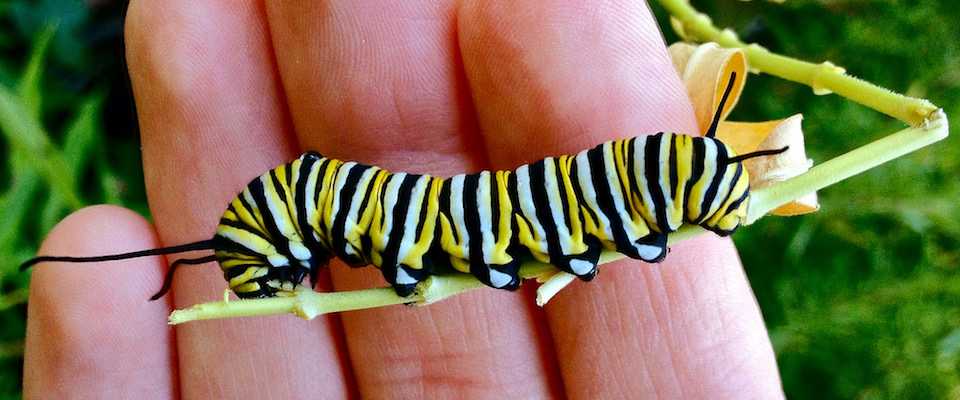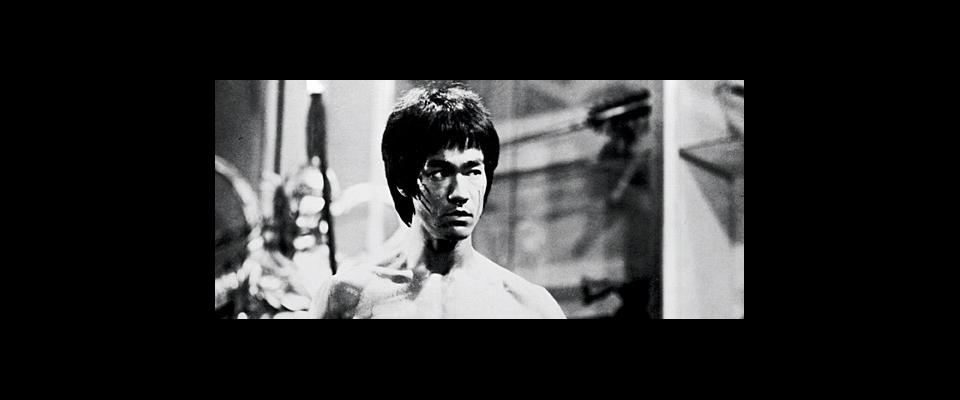UC Berkeley alumni turn up in the most unusual occupations, including bullfighter (Bill Wong, aka El Chino, the world’s first Chinese matador), online gaming mogul (Frank Ng, Eric Yang, and Adam Pliska), and even rocket scientist (Ashley Karp).
Now, add another to the list: Terry Smith, caterpillar wrangler.
She’s a founding member of the Pollinator Posse, an Oakland-based group of volunteers that is transforming the East Bay into a safe haven for those indispensable little critters—including bees, wasps, butterflies, moths, hummingbirds, bats, and flies—that pollinate the crops we humans depend on for survival.
Their traditional habitats are rapidly disappearing due to logging, development, herbicides, and other human encroachments. And if those habitats go away, so will they. And so, ultimately, will we.
Different Posse members specialize in different species, and Smith’s is Monarch butterflies. Her garden is filled with milkweed, the only plant on which they will lay their eggs. As soon as the eggs, which look like tiny white dots, are laid, she carefully gathers them up and carries them into her living room, where she watches over them until they hatch into caterpillars. Then each caterpillar is gently placed on a sprig of milkweed in a cage, where it munches away to its heart’s content until it’s ready for the next stage. That’s when it will move to the top of the cage, transform into a chrysalis, and finally morph into an adult butterfly.
For this purpose, she has amassed what might be the world’s largest collection of 1800 Tequila bottle tops.

“They were supposed to make perfect shot glasses, turn them over and you have one ounce, but their necks are too small, and you have to shake them to get the liquid out. But they’re perfect for holding a single sprig of milkweed for caterpillars. You want something with a narrow neck so the caterpillar won’t fall in the water and drown, and you want the base heavy enough so it won’t tip over.”
It all started with three caterpillars, whom she named Larry, Moe, and Curly. “I didn’t know much of the details of how the process went, so my husband Rob [also a Cal alum] and I were watching them turn themselves into chrysalises. They got to this stage where they hang at the top of the cage in a J as they form the chrysalis, and the outside skin molts off and you see the chrysalis inside.
“Larry and Moe went though this process just fine, but Curly kept hanging in the J and hanging in the J…and we were getting worried. Every time we came through the living room we’d check on Curly, and my husband was partly laughing at me about this and partly totally into it. I finally left the house because I had to go to grocery shopping; and when I got home, as soon as I opened the front door I could hear my husband shouting from the back, ‘Curly’s a chrysalis!'”
Smith is a painter, specializing in close-up portraits of flowers “from an insect’s point of view.” For many years, she also taught a hands-on fourth grade unit on Monarchs at Havens Elementary School in Piedmont, CA, where she and Rob live. One day, as she was walking down the hall, the kids suddenly came pouring out of the classroom: “Mrs. Smith! Mrs. Smith! It’s coming out!”
“I went inside, and unfortunately part of the butterfly’s wing was stuck to the chrysalis, and she couldn’t quite get her wings free.”
(You can tell if it’s male or female because the males have spots on their wings and the females don’t.)
“So here I have this crowd of kids so excited, and this butterfly struggling to get her wing free, and visions of disaster running through my mind. I grabbed a tiny scissors and snipped the piece of chrysalis that was stuck to the wing, and she was able to inflate her wings and all was fine. So I added butterfly midwifery to my list of skills.”
Last year, Smith was able to nurse 130 caterpillars through all the stages, and release the adult Monarchs to join the hundreds of millions of others making their way north and east to cooler climes, mostly Northern Washington or British Columbia, for the summer. And she’s about to release even more this year.
They will never make it to their ultimate destination, but their great-great grandchildren will.
“They’ve been hanging out, not eating, not reproducing, not doing much of anything all winter,” she says. “But in the spring something clicks, and they’re active again. They’ll mate and start eating nectar and start flying north or east, and that generation will very quickly lay eggs as soon as they find milkweed. Then they’ll die, and the next generation goes farther and lays eggs and dies, and so on and so on. That’s about four or five generations working their way up through the mountains in California up to British Columbia, generation by generation.”
Now, here’s the really cool part: “The generation that will make the return trip in the fall is bigger and more robust, and they will fly all the way back in one leg.”
Why is this so? How do they know which way to go?
“We have no idea. We think they probably use the magnetic field of the earth, or they might look at the angle of the sun. But we just don’t know. I mean, it’s only recently that we realized they were doing this.”
Another Posse member, Jackie Salas, the horticulturist at Children’s Fairyland in Oakland, says, “It would be like us going to China and living there for 100 years and then our great-grandkids being able to find the exact place where we started out 100 years ago. How do they do it?”
Mia Monroe, a ranger with the National Park Service in Muir Woods, to whom many in the Pollinator Posse look as an expert on Monarch migrations, thinks she knows the answer: “They pick up on clues from the environment. When they leave Terry’s garden, they become part of the whole western dispersal going from California. They ride around on air currents, looking for milkweed. If you think about spring and summer, spring arrives in the coastal areas first and then rolls sequentially to inland valleys and then the foothills and then the mountains. Generation by generation, they follow spring as spring spreads out north and east and, in a few cases, south.
“But in the autumn the days are getting shorter and cooler, and the cold air sinks to the ground and slides downhill, generally toward the ocean. The closer you get to the water, the milder the temperatures are going to be. So instead of thinking about mating and flowers, they’re thinking about finding a wonderful coastal place where they can hang out and survive the winter. That’s when you see them in clusters and swarms.”

The Pollinator Posse was founded in 2012 by Victoria “Tora” Rocha, the park supervisor for the City of Oakland Public Works Department, who says she was inspired by another Cal grad, landscape architect Andy Liu.
“I heard him give a talk on butterfly gardening at Merritt College, and that’s when I got the epiphany,” says Rocha, whose home base is the Gardens at Lake Merritt, which boasts three pollinator gardens: a native California pollinator garden and two not-so-native pollinator gardens, plus a Bee Hotel for carpenter bees.
And Liu is glad she did. “Tora has taken everything I said and implemented it. I tell people to leave some weeds to provide habitat. But to implement that at the park level? That’s never happened before. We had tried for years to convince city officials to do it, but Tora did it. She was in the right spot at the right time. Her maintenance supervisor position has allowed her to do great things.”
One of the first people Rocha ran into after she heard Liu’s talk was Smith, who was looking for a few caterpillars to foster, and she became Rocha’s first recruit. Thus the Pollinator Posse was born, with the motto “Creating pollinator habitat throughout the Urban Jungle.”
And it’s none too soon because butterfly habitats, indeed, all pollinator habitats, are disappearing at frightening rates.
“Every butterfly has its own special host issues, its own special plant,” says Liu. When you see a butterfly on a flower, that’s the end product. But the flower is not essential to a butterfly; the host plant, where they lay their eggs, is. Nectar flowers are like gas stations; host plants are like affordable housing. One you need for survival, the other you don’t.”
“Monarchs aren’t endangered as a species yet, but their migration is endangered because there’s so little habitat for them now as they go north, so their numbers keep dropping,” adds Smith, and Monroe agrees: “Habitat is everything.”
And in a few instances, success can produce its own set of problems, as Jackie Salas at Children’s Fairyland found out last year when her Monarch population doubled over the previous year’s.
“The downside was that it increased so rapidly, there was also an increase in a pathogen called ophryocystis elektroscirrha that harms the insects,” she says. “So I tested a protocol to essentially eliminate the pathogen from the population, and I did that by collecting the eggs off the milkweed plants and bleaching them in a five percent solution for 60 seconds and the milkweed that was being fed to the caterpillars that emerged from those eggs in a 20 percent solution for 60 seconds. You have to do it in really specific concentrations.
“We have friends at the University of Georgia’s MonarchHealth Project who have pathogen testing equipment, and we sent them samples of adults who had emerged from both bleached eggs and non-bleached eggs. In the bleached population there were zero pathogens, and the non-bleached had at least 25 percent heavily infected with the pathogens. This is citizen science: ordinary people helping the monarchs.”
Fairyland’s Monarch habitat garden is also a popular attraction with the children who visit the park, and Monroe says that might be the biggest benefit of all.
“They’re not only creating a healthy habit; they’re also engaging these kids. Once you look closely at small things, you find insects are an amazing window on the world. So much of it is magic; so much is still a mystery. You never know: The scientist who finally unravels this mystery might be one of these children.”





















